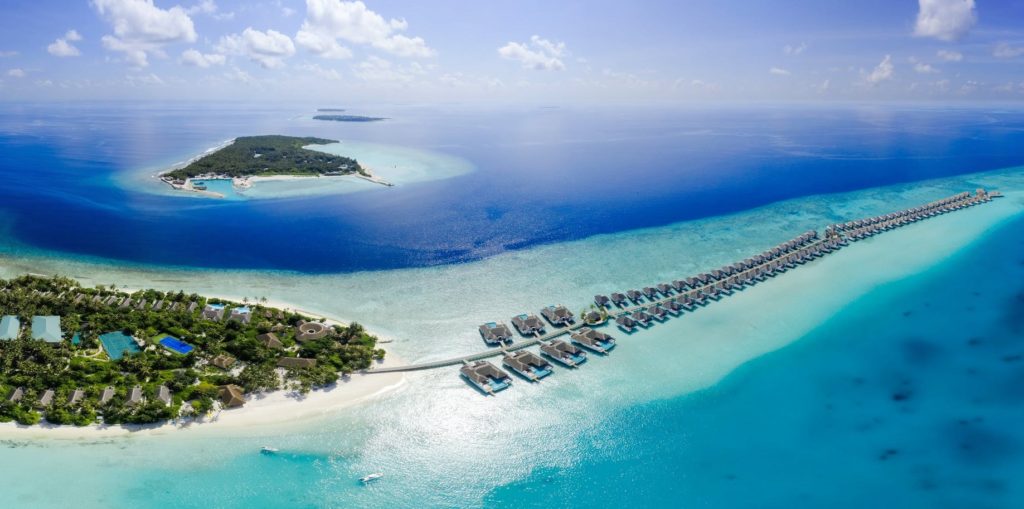Especially after the long Corona period. We show what you shouldn’t miss besides sun, sand and sea.
Warm and humid air blows in my face. I cycle on white sandy tracks through dense green jungle. Birds screech from the thicket, and just a few feet above my head, a dark figure flies elegantly flapping its wings and disappears into the green.
On my way, I encounter many more of these black giants, who disappear again so quickly that I can hardly see what it was.
Only later do I find out that these were Maldivian flying foxes. Native to these islands in the Indian Ocean, these hauntingly beautiful creatures can reach wingspans of almost two meters and can live up to 30 years. They leave their resting quarters, especially in the late afternoon, to feed on nectar and fruit.
Niyama Private Islands: The best surf spot in the Maldives
After 20 minutes I reach my destination. The southern tip of Niyama Private Island, which consists of two islands. They belong to the Dhaalu Atoll with a total of 50 islands and are about a 40-minute flight south of the main island of Malé. I’m surprised, because the island paradise shows itself from a completely different side here: meter-high waves roll in here.
Click for Maldives travel with the best price guarantee every day throughout the year
Because of the southwest and northeast winds, the island is actually one of the best surfing spots in the Maldives all year round, where a lot of professional surfers such as the Australian Josh Kerr have found their way. The good thing about it: Even beginners can get a feel for the sport there and practice in the calm lagoons with crystal-clear water.
Advanced surfers, on the other hand, either go into the water directly in the south of the island and paddle to the Vodi wave or take a boat to the surrounding surf spots. One of them is Kasabu Surf Point, only ten minutes away, which offers great waves for different levels. Or a little further south the Hocus Pocus spot, which is only suitable for experts as it is located directly above a reef.
Deep relaxation: yoga at sunset
Definitely not my league. After a training session with a surf instructor in the calm lagoon, I decide to end the day in a relaxed manner. I jump on my bike and head straight to the yoga pavilion in the south of the island. There Elle Mackie is waiting for me, an Englishwoman who spends a few months on the island to train guests.
After a sweaty 45-minute session that stretched every muscle in my body, I sit in the lotus position on the wooden floorboards and listen to the sea. A few surfers are still making their turns on the waves – behind them the sun is slowly sinking into the sea.
Even without yoga, this view automatically leads to deep relaxation. Especially after the long Corona period, it feels even better to be able to enjoy a break in an exotic place far away from Europe.
Seaplane to Baa Atoll
change of location. The next day I pack my things and get on the seaplane to fly to the next island. A very special experience, because from a few hundred meters above sea level, the white Maldives atolls look like heaps of sugar in the turquoise blue water.
It goes to the Baa Atoll, which has largely belonged to the UNESCO Biosphere Reserve since 2011 because of its coral reefs and biodiversity. A paradise for divers and snorkelers.
One of the most beautiful and also most adventurous underwater experiences that can be found there is the encounter with manta rays. These giant sea creatures, which can be up to seven meters wide and weigh up to two tons, make regular appearances in the waters there.
Swim with the manta rays at Hanifaru Bay
One of these special places is Hanifaru Bay, about 40 minutes by boat from Kihavah Resort. This 600-metre-long funnel-shaped bay has a particularly high concentration of plankton between June and November, and the majestic animals regularly gather in the hundreds to feed during these months.
They then fly through the crystal-clear water with their mouths wide open. Whale sharks, up to ten meters long, the largest fish in existence, like to come there to eat their fill of plankton.
In the early afternoon we leave by boat to witness this spectacle. Hanifaru Bay is now strictly guarded by rangers, and boats are only allowed to anchor outside of the markings. So you have to swim at least 100 to 200 meters to get into the bay. “Stay flat in the water and at least four meters away from the animals and don’t try to touch them, cross their path or swim towards them,” our guide explains. Because under no circumstances should the animals feel disturbed.
Anemone fish, surgeon fish and turtles
I’m excited. The prospect of swimming in a cove with hundreds of giant manta rays as they hunt their prey instills awe. After a short communication with the rangers, our guide enters the water and swims ahead to check the situation.
All eyes are eagerly focused on her. With mask and snorkel on our heads and fins on our feet, we wait at the railing for her hand signal. But we are unlucky, she returns to the boat. “Unfortunately, the buffet has already been cleared,” she tells us soberly. Not a manta in sight. Well, nature cannot be asked at the push of a button. I’m disappointed and at the same time very relieved – even if it’s a shame to have missed these fascinating animals.
